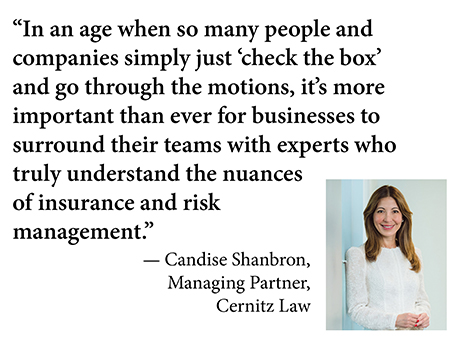By Candise Shanbron, Esq., managing partner at Cernitz Law
No matter where owners of commercial properties stand politically or how they feel about issues like climate change, one undeniable fact is that natural disasters are becoming increasingly common.
In high-risk geographical areas, such as coastal regions and areas that are prone to wildfires, hurricanes, tornadoes and floods, these disasters are happening with greater frequency and intensity. As these events grow more widespread, the conversation surrounding commercial property insurance and risk mitigation has become a central issue. Whether it’s a single building or a large portfolio, understanding the evolving landscape of risk and property management and insurance is important for owners’ long-term success.

Although not related to a natural disaster, it’s worth noting that in the aftermath of the 2021 Champlain Towers South condominium collapse in Surfside, Fla., the state quickly imposed stricter recertification guidelines, such as a 30-year inspection mandate (dictated by the county), with follow-up inspections on shorter time frames. This new mandate has placed an unexpected financial burden on individual condo owners, who now face hefty assessments they did not anticipate when they first purchased their units.
Across high-risk markets like Florida, California and other disaster-prone regions, property owners — commercial and residential — are increasingly facing an insurance crisis. Insurance carriers, wary of the mounting risks, are pulling out of certain markets, leaving property owners with limited options or in some cases, no coverage at all. This reality has come into greater mainstream focus in recent weeks as Southern California has battled devastating fires. For the fortunate few who are able to secure insurance, they may encounter policies that come with stringent limitations or even outright exclusions on key coverages.
A New Ballgame
The result is that commercial owners and operators are going to feel more of a burden on how they maintain their buildings. Building owners and operators will be expected to take more proactive approaches in terms of investing in both new technologically advanced infrastructure and the ongoing maintenance of their properties. The goal is to not only prevent catastrophic damage but to also make the property more attractive to insurers that are increasingly looking for buildings that are well-maintained and have strong risk mitigation measures in place. This means more time and resources will be dedicated to collaboration between property management teams, risk management teams and insurance brokers.
Commercial property owners will also need to spend more time with their risk management teams to understand the full spectrum of insurance coverages they require. Property owners will need to determine what types of coverage are necessary and which may be unnecessary or redundant. This is no small task. Even the most experienced risk managers may lack the deep knowledge required to navigate the intricacies of modern insurance policies, especially in disaster-prone areas.
For example, some insurers are offering premium credits for buildings with flat roofs to be treated with elastomeric coatings, which act as a shield/barrier and are intended to prevent roof leaks. Insurers may also offer credits for hurricane-resistant windows, doors and other mitigation measures designed to reduce the damage caused by wind. Some insurers may be drawn to buildings equipped with technologies that can predict or prevent damage before it happens. Systems that detect leaks, monitor flood risks or provide early warnings for potential hazards can all improve a property’s insurability.
In an age when so many people and companies simply just “check the box” and go through the motions, it’s more important than ever for businesses to surround their teams with experts who truly understand the nuances of insurance and risk management. That’s especially true in the context of commercial property insurance, where even small oversights can lead to significant financial consequences. Having the right team in place is no longer just a best practice; it’s an essential component of running a successful property management operation.
Alternative Solutions
As obtaining insurance becomes more difficult in certain regions, property owners will also need to explore alternative methods of coverage. This could involve seeking out foreign insurance companies that are willing to take on higher-risk properties or considering hybrid models that combine traditional insurance with self-insuring. Some international insurers are even requiring in-person meetings with property owners and operators to vet the risks involved before agreeing to provide coverage. This kind of direct engagement guarantees that insurers have a clear understanding of how well the property is managed, how risks are mitigated and how prepared the owner is for potential disasters.
It’s also worth noting that not all insurance brokers and agencies are created equally. Many property owners believe that working with a single, large, reputable insurance agency is enough to secure proper coverage, but that’s not always the case. The reality is that no single broker or agency can offer a comprehensive range of products suitable for every type of risk. For this reason, risk management teams should work with multiple insurance brokers and agencies who represent a variety of carriers. This not only provides more options but also increases the likelihood of finding the best fit for your specific property.
In conclusion, the landscape of commercial property insurance and risk and property management is undergoing significant changes. As natural disasters become more frequent and intense, property owners and operators will need to be more proactive in managing their properties and securing appropriate insurance coverage, and they will need to get even more creative on how they are getting insurance coverage.
Whether through investing in mitigation technologies, working with a diverse range of insurance brokers or exploring alternative coverage models, commercial property owners will need to adapt to more and new responsibilities when it comes to risk and property management. Those who are able to do so will not only protect their properties but will also be better positioned to navigate the evolving insurance climate.
Candise Shanbron, Esq., is a managing partner at Cernitz Law, which has offices in Florida, New York and Texas. She has dedicated her entire legal career exclusively to the practice of property insurance law. Shanbron spent the first part of her career representing insurance companies, giving her a unique perspective and advantage in representing policyholders. Since 2008, she has zealously advocated on behalf of policyholders.


